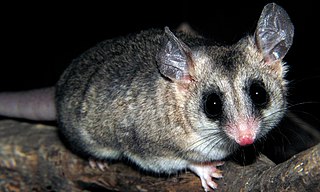
Caenorhabditis elegans is a free-living transparent nematode about 1 mm in length that lives in temperate soil environments. It is the type species of its genus. The name is a blend of the Greek caeno- (recent), rhabditis (rod-like) and Latin elegans (elegant). In 1900, Maupas initially named it Rhabditides elegans. Osche placed it in the subgenus Caenorhabditis in 1952, and in 1955, Dougherty raised Caenorhabditis to the status of genus.

Crassostrea is a genus of true oysters containing some of the most important oysters used for food. Some species in the genus have been moved to the genus Magallana.

Elmisaurus is an extinct genus of dinosaur from the Late Cretaceous. It was a theropod belonging to the Oviraptorosauria. Its fossils have been found in Mongolia. It is known from foot and hand bones.

Banksia elegans, commonly known as the elegant banksia, is a species of woody shrub that is endemic to a relatively small area of Western Australia. Reaching 4 m (13 ft) high, it is a suckering shrub that rarely reproduces by seed. The round to oval yellow flower spikes appear in spring and summer. Swiss botanist Carl Meissner described Banksia elegans in 1856. It is most closely related to the three species in the subgenus Isostylis.

Cicindela, commonly known as common tiger beetles are generally brightly colored and metallic beetles, often with some sort of patterning of ivory or cream-colored markings. They are most abundant and diverse in habitats very often near bodies of water with sandy or occasionally clay soils; they can be found along rivers, sea and lake shores, sand dunes, around dry lakebeds, on clay banks, or woodland paths.
The lesser small-toothed rat or western small-toothed rat is a species of rodent in the family Muridae. It is found only in West Papua, Indonesia.

The elegant fat-tailed mouse opossum, also known as the Chilean mouse opossum, is an opossum from central Chile. The type species of Thylamys, it was first described by English naturalist George Robert Waterhouse in 1839. This medium-sized opossum is characterized by black rings around the eyes, white limbs, gray to light brown coat, lighter flanks and underbelly and a thick 12.7–14.6 centimetres (5.0–5.7 in) long tail covered with hairs. It is crepuscular and lives in nests in tree hollows or under rocks and roots. This opossum feeds mainly on arthropods and larvae apart from fruits. Litter size is typically between 11 and 13. The elegant fat-tailed opossum can occur in a variety of habitats – from cloud forests to chaparrals. The IUCN classifies the opossum as least concern.

The spotted giant flying squirrel, also known as the lesser giant flying squirrel, is a species of rodent in the family Sciuridae. It is found in hill and mountain forests at altitudes of 200–4,000 m (660–13,120 ft) in Southeast Asia north to central China and the east Himalayan region, although the northern populations sometimes are regarded as separate species as the grey-headed giant flying squirrel, Chindwin giant flying squirrel and P. marica. Two of these, as well as a few other populations, lack the white spots on the upperparts for which it is named. Although a large flying squirrel, it is a relatively small giant flying squirrel.

The Wyoming ground squirrel is a species of rodent in the family Sciuridae.

The western terrestrial garter snake is a western North American species of colubrid snake. At least five subspecies are currently recognized.
Garra elegans, previously Hemigrammocapoeta elegans, is a species of cyprinid fish. It is a benthopelagic freshwater species endemic to the Euphrates – Tigris basin in Western Asia.

The West Cornwall Bryophytes Site of Special Scientific Interest is a group of seven locations of former mining activity, that form a single SSSI and Important Plant Area in western Cornwall, England, United Kingdom. The site is noted for its biological characteristics and derives its name from the rare bryophyte species found there.

Cephaloziella is a genus of liverworts. Cephaloziella varians(Gottsche) Steph. is the only liverwort that occurs in the continental Antarctic.
Semotivirus is the only genus of viruses in the family Belpaoviridae. Species exist as retrotransposons in a eukaryotic host's genome. BEL/pao transposons are only found in animals.

Bryum elegans is a species of mosses in the family Bryaceae. It is found in Norway, Poland and the Russian Federation.
Anisothecium elegans is a species of mosses in the family Dicranaceae. It is found in Chile.
Bucklandiella elegans is a species of moss in the family Grimmiaceae. It is found in New Zealand.

Citipes is an extinct genus of caenagnathid dinosaurs known from the Late Cretaceous Dinosaur Park of southern Alberta, Canada. It lived about 76.9–75.8 million years ago. The specializations of the beak in Citipes and other caenagnathids suggest that they were herbivores. The type species, C. elegans had been previously placed within the genera Chirostenotes, Elmisaurus, Leptorhynchos and Ornithomimus.












